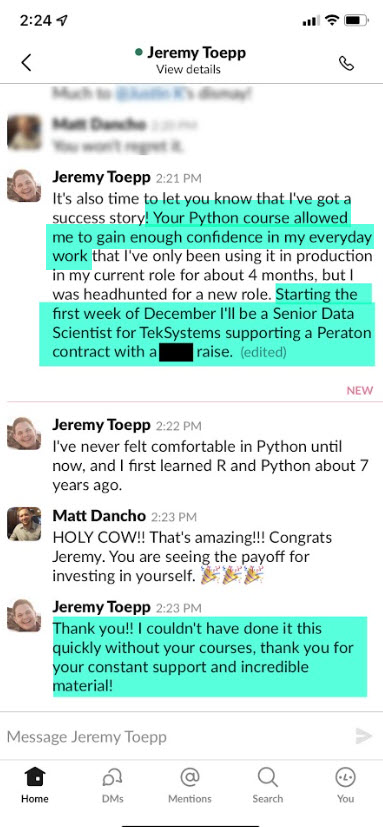Why learning Python is hard (but important) for Data Scientists that use R
Written by Matt Dancho

Learning python is hard. But it’s important…
Even for R users like me that have built successful careers as a Data Scientist, Consultants, and Trainers.
Even for future data scientists that are just starting out trying to get a leg-up in the job market.
And even for old dogs that are doing the best to keep up with the ever-changing data science ecosystem (As I approach my 39th birthday, I guess I’d fall into this category now).
So why am I “all of a sudden” learning and promoting Python?
Well, I am not.
(Read on to understand why I still think R is the better language to start with for data scientists that need to do business analytics)
(And while you’re at it, quit putting words into my mouth. I’m an R guy through-and-through.)
Back to my story…
Python was my first data science language (before I learned R)
I began learning Python in 2013 when I was just a naive doey-eyed sales manager trying to figure out how to analyze customers for my company.
Back then, I didn’t know what machine learning was.
Heck, I couldn’t even spell “API”.
I was just trying to get reports to my boss so I could win us more business (and actually make sense of what I suspected was going on with our “customers”).
My problem wasn’t that complex.
I had a sneaking suscpicion that my small team of rag-tag inside salespeople were spending too much time on the wrong customers. And I suspected that it was costing us business.
What tool was I using every day?
❌ Python
❌ R
✅ Excel
I was pulling in data from our customers, and trying to make sense of it all inside of… (Ahem)… Excel.
And eventually…
Excel crapped out.
Yep, the trusty tool that I’d spent the better part of decade mastering crapped out.
I was an unofficial Excel ninja.
I knew VBA like the back of my hand (and that was kind of like coding… well sort of)
And I could do all of the cool tricks like Pivot Tables, Slicers, and even the new “Power” series of tools were coming out. You know… PowerBI, PowerQuery, PowerRangers…
But, my trusty Excel crapped out on me.
Fun Fact: Excel has this weird limitation that it can only pull in 1,048,576 rows of data.
(And my data was bigger than that.)
So I picked up Python
Yes, I read all the blogs. All the forums.
Researched Reddit. Scoured LinkedIn. Sifted through Twitter.
And all the research was pointing to…
Python. (because everyone even back then was saying it was “the best”, surely it was the best, right?)
And guess what happened?

After 3 months of using Python, I quit trying to become a Data Scientist
Yep. I gave up. Took several months off. Why?
Python was hard.
I was getting bogged down in coding.
I couldn’t think through business problems because I was struggling trying to figure out how to set up an environment.
And then I’d finally get something working, update my environment, and it would break everything.
I didn’t get classes. What the heck was a “method”?
I couldn’t understand matplotlib to save my life (and still don’t, thanks to plolty).
And why was this so fricken’ tough?!
So I switched languages. And here’s the God’s-honest truth…
R was easier
It’s as simple as that.
I had invested months learning Python. And I made the decision to switch.
I knew that going backwards to Excel was NOT the answer.
So I tried R. And it was easier.
Yeah, the first week sucked. I was banging my head on the table trying to get R installed and libraries loaded.
But in that first week I did things that I failed to do with Python:
-
I could visualize my data! (thank you ggplot2).
-
And I could make a regression (thank you stats).
So to this day, I recommend any beginners that are struggling with Python to give R a try.
It is easier.
But why Python, and why “now”?
I made a decision 3 years ago to pick Python back up.
2 years ago I launched my first Python course for the student that was in the same spot as I was…
I made if for those of us that are struggling to learn Python. Struggling to make a damn matplotlib plot. Stuggling to do a regression. And stuck (because we’re not coders, we are business analyzers).
And many of the success stories were students like Jeremy, who got a Senior Data Scientist job after taking my first Python course…

And this is what’s important to understand about Jeremy:
-
Jeremy learned R first
-
He picked up Python because some jobs “need” it for production (yeah you can do production with R too)
-
He never felt confident in Python until he learned Python from someone like him (who understood where he was coming from)
-
And Jeremy became confident after learning from an R user
The result was a big raise (I can’t say how much, but it was a lot).
Plus, he’s getting to do what he wants to do: Production.
The truth is…
Python takes your excuses away
Can you get a job with R? Absolutely.
Are there fewer R jobs than Python jobs? Yep.
Is there also less competition? 100%.
But, if you think you need Python to get a job or grow your career, then you should learn it.
Why?
To help your (future) company NOT fall into the trap of having 87% of their projects fail
Wait, what?
Did Matt just say, “87% of data science projects fail?”
I did.
And it’s why Python and R users are getting fired (or I guess the term is, “restructured”).
Most people think it was the Recession that is causing data scientists to lose their job.
It’s not. The truth is…
Your job is on the line because your data science team isn’t productive
I know this because I was horribly ineffective with my first Fortune 500 consulting project.
I was hired by a company that does $8,000,000,000 every year to help them with an HR Analytics job.
And guess what- Matt, the self-proclaimed king of consulting… Failed miserably.
(By the way, I am particularly good at data science consulting. I pulled in $500,000+ in my 2nd year. So it wasn’t all downhill from this “failure”.)
Why did my “BIG” Fortune 500 Project Fail?
It’s simple. Because like most data scientists I was trying to solve what I thought was the problem:
❌ Predicting Employees that Would Leave The Company.
That’s what they told me they wanted.
And when I gave them a model that predicted exactly that on a big presentation that I worked all weekend on… I got dead silence in return.
And one day later I got fired.
So yeah, I know why data science projects are failing.
It’s because you’re trying to do data science.
Instead of solving the real problem:
✅ Making the Company More Money
So fast forward to today.
My success rate on data science projects (after my failure) is 100%.
And I want to help you unlock this power… with Python.
I’m giving away my Pythonic Framework that virtually guarantees project success (and turns you instantly into a leader) on Thursday at 2PM EST
I’m launching my 2nd Python Course: Python for Machine Learning and API’s. And to celebrate I’m having a live launch party.
Inside the launch party, I’ll share:
- Which tools I use in Python
- What steps I take (every single time)
- Where I use those tools
- How to incorporate Machine Learning
- How to deliver a “production” solution in minutes
- How to become the go-to leader in your company
- And how to fill your portfolio with projects that generate job demand
Live Launch Party (For My NEW Python for Machine Learning and APIs Course)
What: Live Launch Party (NEW Python for Machine Learning and APIs Course)
When: Thursday May 25th, 2pm EST
How It Will Help You: Whether you are new to Python or are an expert, making the company money is what you need to be focused on. That’s why 87% of projects fail. But how can you be different? I’ll show you in side my free Python for Machine Learning and APIs Course Launch Event.
Price: Does Free sound good?
How To Join: 👉 Register Here
See you there!
-Matt